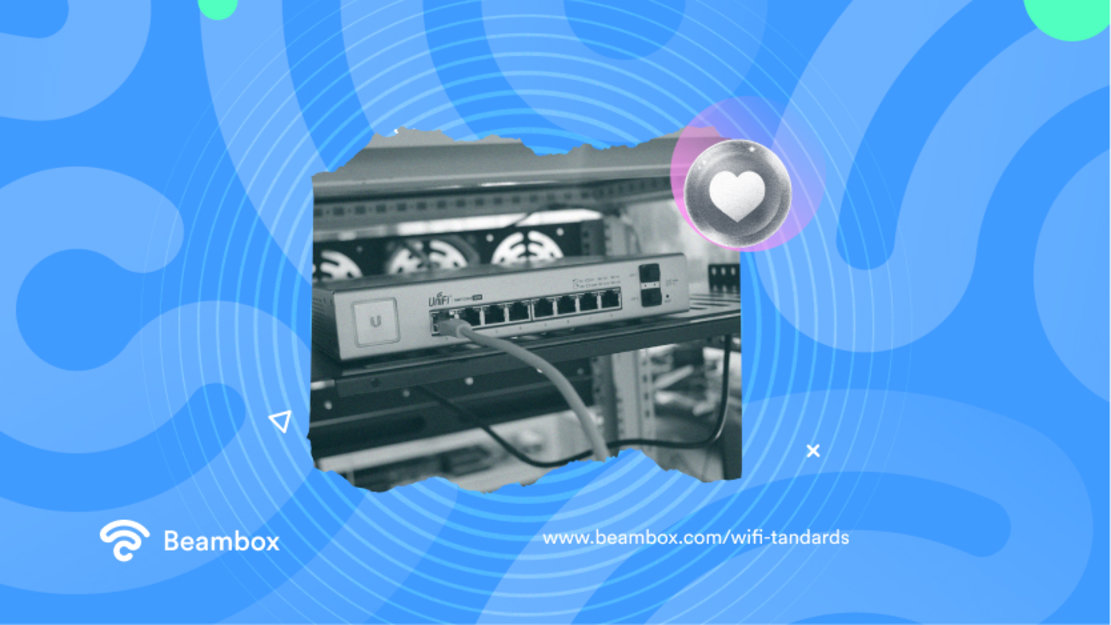WiFi Standards: History, Performance, Differences
Are you curious about WiFi standards?
This article explains WiFi standards and offers an overview of key milestones like WiFi 4, 5, and 6. You’ll also read about WiFi 7 and tips for optimizing your connection and its security.
Let’s start!

What Are WiFi Standards?
A WiFi standard is the set of rules that WiFi devices follow to communicate with each other over a network. The WiFi Alliance creates these standards, which control several connection aspects. The main characteristics of a standard include:
- Speed: how fast data can travel across the WiFi network
- Range: how far the signal can reach while maintaining a strong connection
- Device capacity: how many devices can connect without slowing down the network
- Frequency bands: the GHz bands (2.4 GHz or 5 GHz) that the standard uses to send data
- Security: the level of protection the standard offers to keep data safe

Evolution of Standards in WiFi
It’s helpful to examine the different standards to understand how WiFi has evolved. Each new version brought improvements, making it easier to manage WiFi networks as technology advanced.
- WiFi 1 (802.11b): This was the first widely adopted WiFi standard. It operated on the 2.4 GHz band with a maximum speed of 11 Mbps. This was groundbreaking then, allowing devices to connect to the internet wirelessly. However, it struggled with interference from household devices like microwaves.
- WiFi 2 (802.11a): Launched the same year as WiFi 1 (1999), it used the 5 GHz band and offered faster speed. This standard reduced interference but had a shorter range. It was mainly used in business environments.
- WiFi 3 (802.11g): WiFi 3 combined the best of the previous two standards and became widely popular for home networks. It balanced speed and range. However, there were still issues with interference.
- WiFi 4 (802.11n): Launched in 2009, WiFi 4 was a big step forward. It introduced the possibility to use the 2.4 GHz and 5 GHz bands (dual-band). It also brought faster speeds and allowed more devices to connect without losing performance. WiFi 4 marked the moment streaming and gaming became reliable hence popular.
- WiFi 5 (802.11ac): WiFi 5 focused entirely on the 5 GHz band and dramatically improved speeds. It supported multiple devices at once and boosted performance, becoming the go-to for most modern businesses and homes.
- WiFi 6 (802.11ax): WiFi 6 is the latest WiFi standard (although 7 is coming.) It is dual band and can manage crowded networks. It is ideal for businesses offering free WiFi and social hotspots.

WiFi 7: A New WiFi Standard for Unparalleled Wireless Connectivity
WiFi 7 is a new WiFi standard expected to bring a massive leap in speed and performance. It’s set to deliver speeds over 5.8 Gbps, far surpassing the capabilities of WiFi 6.
This new standard will operate on the 2.4 GHz, 5 GHz, and the super-fast 6 GHz frequency bands.
WiFi 7 will provide better efficiency and easily handle even more connected devices.
Additionally, it will offer ultra-low latency, making it perfect for virtual reality (VR), gaming, and Internet of Things (IoT) devices.
Businesses leveraging WiFi marketing tactics will be able to provide a more reliable connection, even in crowded environments.
WiFi 7 can also support new technologies, like 8K streaming and holographic display. This marks a new era for marketing and digital signage.
The WiFi Alliance introduced the standard in January 2024. However, the final approval of the standard should arrive by the end of 2024,

What is a WiFi Standards Chart?
A WiFi standards chart lists the various standards and shows how they differ in terms of speed, range, and bands. Professionals use these charts when comparing devices or network setups to ensure optimal performance.
These charts provide an optimal overview of the evolution of WiFi technologies, helping users decide what standards to use for their needs.
Here, you can find a well-designed WiFi chart that can help you adjust the settings of your internet connection.
Tips To Get a Stronger Internet Connection
The standard of your WiFi connection affects the speed and capabilities of your internet. However, other elements impact overall performance.
To make your WiFi connection more reliable and avoid the issue of a WiFi network not showing up, follow these tips:
- Place your router centrally to ensure even coverage throughout your space.
- Avoid physical obstructions like thick walls or large metal objects, which can weaken the signal.
- Reduce interference by keeping your router away from other electronic devices (microwaves, cordless phones, etc.)
- Update your router’s firmware regularly to improve performance and security.
- Consider using a mesh network or WiFi extenders if you need to cover a large area or multiple floors.
- Limit the number of devices connected at the same time.
- Use wired connections for devices that don’t need to be wireless, like desktops or gaming consoles.
Following these tips will help ensure a more stable and faster WiFi connection, no matter which WiFi standard you’re using.

Network Security and WiFi Protocols
WiFi standards play a crucial role in network security because they bring improvements in encryption and other protective features.
For example, WiFi 6 includes stronger security protocols like WPA3. This offers better encryption and protection compared to WPA2.
Encryption protocols protect your network from unauthorized access and keep data safer as it travels across your network.
As WiFi evolves, security protocols become more robust, making it harder for attackers to exploit vulnerabilities. However, the user will always play a role in the security of the network.
The following are a few tips to consider and implement:
- Regularly update your router’s firmware to fix security vulnerabilities and bugs.
- Enable WPA3 encryption, the latest and most secure WiFi encryption standard.
- Disable remote management to reduce the risk of external attacks on your network.
- Create a guest network for visitors, keeping your main network more secure and limiting access to sensitive data.
- Use a virtual private network (VPN) to encrypt the traffic and protect sensitive information when accessing the internet.
- Use a firewall to add an extra layer of protection to your WiFi network.

FAQ on WiFi standard
When it comes to the standard for WiFi, a few common questions might arise. Let’s answer them.

What is the latest WiFi standard?
The latest WiFi standard is WiFi 7. However, most available devices today still use WiFi 6 and 5. These offer great performance for everyday use. As WiFi 7 becomes more common, businesses will benefit from its higher speeds. However, previous standards will work well in many cases.
Is WiFi 7 better than Ethernet?
WiFi 7 can potentially match or exceed Ethernet speeds in many cases. However, Ethernet still tends to offer a more stable and consistent connection. WiFi 7 provides mobility and ease of setup, so it’s better for flexible devices.
What is the WiFi Alliance?
The WiFi Alliance is an organization that develops and certifies WiFi standards to ensure devices work well together. It is responsible for creating guidelines; its certifications help determine whether a device meets certain quality and performance standards.
You Don’t Need the Latest WiFi Standard to Grow Your Business
WiFi standards are important for your connection, ensuring better speed and reliability. However, you don’t need the latest WiFi standard to take advantage of it. If you run a business, you can capitalize on it.
Beambox offers a complete WiFi marketing solution that helps businesses:
- Gather insights into customer behavior
- Automate marketing activities
- Secure their network
- Use data to personalize marketing campaigns
Take control of your WiFi and boost your business. Start your trial now!



